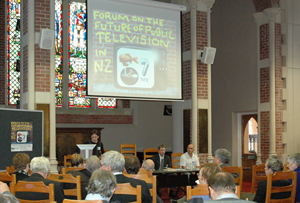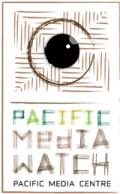
Trisha Dunleavy, David Beatson and Peter Thompson
WELLINGTON (Victoria University/Pacific Media Watch): New Zealand’s Forum on the Future of Public Broadcasting brought together more than 60 participants representing stakeholders across the television industry, academia and the state sector.
The panel presentations and debates covered a range of issues including funding mechanisms for public broadcasting, challenges to the free-to-air sector and local content and regulatory issues. Spokespeople from the Green Party and Labour and also the Save TVNZ 7 campaign also presented.
Spokespeople from the Green Party and Labour and also the Save TVNZ 7 campaign also presented.
There were significant concerns about the sustainability of public television outcomes in the context of profitability shifting from the free-to-air sector (which commissions the majority of local content) to Sky (which commissions almost no local content outside sports).
There was general support for the retention of a non-commercial television channel (like TVNZ7) as an outlet for the creation and screening of a broader range of local TV programmes and whose public role would complement Maori TV’s remit and contributions.
The issue of who operates this channel and what its primary remit would be was not discussed in depth but the possibilities included its function or its programmes going to Stratos (whose CEO offered to screen them, though a public institution would need to fund them).
The importance of the New Zealand on Air (NZoA) contestable funding system to sustaining the local production industry and free-to-air provisions was broadly supported by forum participants, although it was recognised that this may not be sufficient on its own to deliver all public broadcasting outcomes.
Funding priorities
There was some concern about the need to update the funding priorities set by the 1989 Broadcasting Act and to recognise that New Zealand’s approach is delivering one of the lowest levels of local content to be seen in the developed world.
There was also concern that the increasing commercial pressures on the major free-to-air networks, particularly increasing competition for advertising revenue, will narrow the focus in local content to productions designed for appeal to the most active consumers in society – the 25 to 54-year-olds – and diminish service to the large proportion of our population outside that group.
Given the cultural importance of NZoA-funded programmes, no-one wanted to see NZoA funding reduced so as to make it possible to operate a non-commercial channel.
Moreover, if NZoA gained new responsibilities to facilitating the production of programming for a non-commercial channel, then new money would need to be added to its existing TV funding purse.
There was strong consensus about the need for new additional funding to be invested in this sector, a shared sense that the existing fiscal allowance "envelope" for television was insufficient.
Because the digital and intensely competitive environment is one characterised by rising costs, increasing opportunity costs for commercial networks, and a declining ability to invest in local TV programmes, more money needs to be invested in public television outcomes.
The existing funding pool is not enough to meet the range of needs for public television in our minimally regulated and changing digital media environment. If additional (specifically new) public funding cannot be found for this, then the establishing and mining of alternative funding streams is the only other option.
The feeling was that new regulatory measures need to be explored because these could resolve some of the existing problems by serving two main purposes.
Sustainable balance
One is they could help to maintain a sustainable balance between different operators within our TV system, with New Zealand’s television ecology currently imbalanced by the rising profitability of Sky at the expense of the free-to-air sector.
The other, is to yield a means to remunerate and support the broadcasters, funders, and producers of local content to encourage them to create this content. There were several suggestions for alternative funding mechanisms that went beyond the options that the government has yet considered.
For example, the Green Party’s suggestions in this regard (specifically the idea of a charge for spectrum which could be refunded in return for local content commissioning) were seen to have real potential.
This forum was probably unprecedented in discussions of New Zealand public television for the reason that it generated interest, support and broad agreement across key stakeholder groups (the TV networks, screen production industry, public broadcasting institutions, politicians, and media academics) and around the above issues; particularly that current provisions for public television are insufficient, and that public television outcomes cannot be sustained unless government intervention occurs to rectify the problems.
There was broad support for the creation of a Public Media Foundation, initially as an interest group to pursue the above goals. This would be representative of a range of key stakeholders in the broadcasting sector.
This summary was compiled on 24 June 2011 by media studies senior lecturers Dr Trisha Dunleavy and Dr Peter Thompson of Victoria University and independent media commentator David Beatson. It was produced on behalf of participants in the Forum on the Future of Public Television in New Zealand held at Victoria University of Wellington, 22 June 2011.



